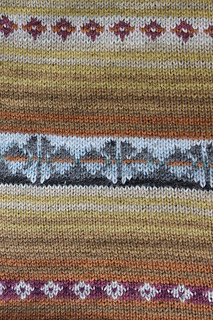patterns >  Sunday Knits and 1 more...
Sunday Knits and 1 more...
> Painted Desert














Painted Desert
Buy 3 get 1 free. Place 4 patterns in your cart and the least expensive one will be free!
Ombre stripes with stranded stars, flowers and arrows in a purl-free stockinette stitch poncho. Yes, that’s right! … every row is a RS row, and the only purl stitches you’ll work are in the ribbing! And the fringe allows for lots of color changes with practically no loose ends to deal with.
Painted Desert is worked flat in one piece forming a rectangle that is folded with a single seam from ribbed border to shaped neckline. An open or buttoned ribbed cowl is picked up and knitted.
Pattern contains all the information you’ll need to either replicate my colorway (lists and charts) or to create you own (suggestions on selecting colors and what order to work them in).
Two sizes: The finished folded poncho forms a 21-1/2 (25)“ by 25” retangle (not including 3-1/2” fringe along one edge). From center neckline to corner tip is 27 (29)”. Ribbed cowl is 25” around and 8” deep. Shown in smaller size in pictures 1-4, larger size In pictures 5-7.
Yarn: Sunday Knits 3 ply yarn (light sport weight - 246 yds / 225 m per 50g skein): Eden (100% merino), Nirvana (92% merino 8% cashmere) and/or Angelic (75% merino 25% angora).
Substitute any light sport weight wool-blend yarn that works nicely to gauge: approximately 1600 (1950) yd total yarn length. If working in four colors: 250 (300) yd each of lightest and darkest colors, 550 (600) yd each of the two mid-range colors.
Needles & notions: Size 5 US / 3.75 mm circular needles (with a cable long enough to hold 150 sts), tapestry needle, four 3/4” buttons.
Gauge: 24 sts and 32 rows = 4” in Stockinette stitch.
Techniques used: Stranded knitting (right side only), pick up and knit, basic increase and decrease stitches.
Pattern includes: Written instructions, glossary, color sequence of sample is written and charted, stranded sections are charted.
Kits are available in two 14-color colorways and in several 4-color colorways. Or create your own! This stash bin contains the full palette of Sunday Knits yarns - feel free to slurp the photos and play with different color combos.
Etymology: Hombre is a noun of Spanish origin (from the Latin homin-, hominidae) meaning man, and used most especially to describe a particularly tough and manly type of man.
The use of striping as a way to blend a broad swath of colors is a hallmark of traditional hand-woven woolen goods, most notably from Central America. Such colorful striping would often be seen in blankets, serapes and ponchos worn and used by south-of-the-border cowboys and other tough guys … hombres.
In the 1940’s-60’s, as westerns became one of the most popular entertainment genres in film and on TV, North Americans became increasingly aware of this traditional weaving style, and adopted “hombre” stripes and “hombre” shading as their own.
Since then, hombre-style woolens and hombre shading have bounced in and out of fashion, and on one of those bounces back in, the industry collectively anglicized the term … “ombre” … dropping the silent “h” while preserving the pronunciation.
The French, ever astute regarding fashion, have also recognized the beauty of the style and they too adopted the term while giving it … “ombré” … a distinctly French pronunciation.
And most recently, Americans, owing to their enjoyment of all things French, have reconnected in a new way with their old hombre, and the term has come full circle. The French “ombré” is now de rigueur for fashionable Americans when describing a broad swath of gradient color, especially when stripes are used as a method of shading. I may be dating myself, but am sticking with the original spelling.
930 projects
stashed
841 times
1255 projects
stashed
1324 times
1053 projects
stashed
841 times
- First published: August 2015
- Page created: August 5, 2015
- Last updated: June 24, 2022 …
- visits in the last 24 hours
- visitors right now




